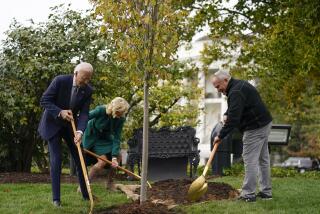Watch out for that tree, home buyers
Furnace firing well? Check.
Roof in decent shape? Check.
Basement dry? Check.
Home buyers have a lot on their list. Those lovely trees are seldom near the top. Perhaps they should be.
If there’s a lesson in the lashing storms that whip through from time to time, it’s this: Trees are not indestructible. They’re only human, you might say. And when they snap or fall — as they have under the force of near-hurricane winds — the cost of cleaning and fixing up can exceed that of many home maintenance projects.
Andee Post, a broker/associate with Goldstar Realty/GMAC in Oradell, N.J., said clients never questioned her about trees until after the devastating storm. But a home she is listing in Bergenfield, N.J., has a towering tulip tree in the back and a soaring maple out front, “and for the first time, I’m hearing it,” she said. “People are nervous about the trees.”
Sharry Friedberg, a Realtor with Coldwell Banker in Hillsdale, N.J., says just one in three home buyers shows interest in the trees on a property. The trees at her River Vale, N.J., home are of great interest: Five fell during a March 13 storm, at a cost of $3,400 for removing them.
To be sure, what happened March 13 was a rarity. Ground softened by one of the snowiest winters in memory, combined with a violent rainstorm, caused an unprecedented number of trees to fall. Several North Jersey homes were virtually destroyed when huge trees crashed down on them.
That storm “was by far the worst,” said Paul Cowie, a consulting arborist whose Parsippany company, Paul Cowie & Associates, has been in business more than 20 years.
“What made it so was that so many of the trees that came down were perfectly good trees. Nothing wrong with them. This was just a rare event: Excessive soil moisture and high sustained winds caused the soil, and then the trees, to fail.”
TREES STILL AN ASSET
So what’s a home buyer to do? Look for properties whose only trees are squat Japanese maples? Budget for removing those towering shade trees?
Of course not. You want to have trees. They are essential to a property’s visual appeal. They purify the air, their roots soak up storm water that might otherwise seep into the basement, and their shade helps cool the home. “On a hot summer day, the air temperature under the canopy of a good-sized tree can be 10, 20 degrees cooler than out in the sun,” Cowie said. “And when those trees are located around the house, they can significantly reduce energy consumption.”
Research has shown that trees enhance a property’s value. A recent study by the U.S. Forest Service said that, all things being equal, the presence of street trees raised home values by an average of $7,000 in one Portland, Ore., neighborhood.
“I’ve seen the evidence,” said Eric Drost, a former landscape designer who is a sales associate in the Pompton Plains, N.J., office of Weichert Realtors. “Homes on beautiful, tree-lined streets sell faster.”
But owning a property that has trees means caring for them and being mindful of the problems they might bring.
Leaves and other debris from trees clog gutters, leading to drainage problems. Roots invade sewer lines, increasing the potential for basement sewage backups.
Trees overhanging a house create a host of problems. If they blot out too much sun, moss can grow on roof shingles, shortening the roof’s life. Overgrown trees whose limbs and branches touch the roof form a bridge for termites, carpenter ants and other pests. Home inspectors usually note when limbs and branches touch the house and suggest trimming.
Ellen Fattal, owner of Home Net Services and Inspections in Wayne, takes it a step further. If her inspectors believe a tree is sick, they will advise the home buyer to call in a professional arborist.
“People kind of think that trees come with nature and you just leave them be, but they have to be maintained,” Fattal said. “If they are being attacked, they need to be sprayed. We’ve seen trees hollow because of carpenter ants, and the homeowner doesn’t even know.”
MAINTENANCE IS KEY
Cowie says it’s rare for arborists to become involved in the home-inspection process. He suggests homeowners have an arborist look at and service the trees on a regular basis – at least once every year.
“When you own a house, everything changes over time — the driveway, the pool, the roof,” he said. “Trees are no different, and they are probably at greater risk because they are living objects. You need to monitor them before they develop problems and take action at the early stage. That includes good, routine pruning; the application of chemicals (for insects or disease); cultural treatments such as aerating or mulching the soil, and correcting soil deficiencies.”
Trees don’t live forever. “A red oak, for example, has the capacity to live 200 to 300 years, but in (some areas) they rarely do, and that’s because of where they grow,” Cowie said.
“Along the street is the worst place for a tree. There is limited space for their roots, there are de-icing salts; there are power lines overhead; and water and gas lines are periodically dug up, damaging their roots. Everything goes on at curbside,” Cowie added. “Trees on the lawn do better and live longer.”
Excavation is one of the worst things for a tree. You should determine whether any construction has occurred within the drip line, which is the area under the outer circumference of the branches. New patio? New walkway? New driveway? An addition to the house? Soil compaction poses great harm to tree roots, and when the roots are compromised, the entire tree is vulnerable.
Speaking of vulnerable, that may well describe many trees that withstood the wicked nor’easter.
“It’s important to understand we went through a severe storm with high winds that weakened many trees in this area,” said Jim Magliaro, an appraisal training manager with Warren-based Chubb Personal Insurance and an expert on storm preparation. Such trees, he added, could come down in a future storm.
All the reason to pay more attention to those lovely trees.
———
(c) 2010, North Jersey Media Group Inc.
Visit The Record Online at https://www.northjersey.com/
Distributed by McClatchy-Tribune Information Services.
More to Read
Sign up for Essential California
The most important California stories and recommendations in your inbox every morning.
You may occasionally receive promotional content from the Los Angeles Times.






